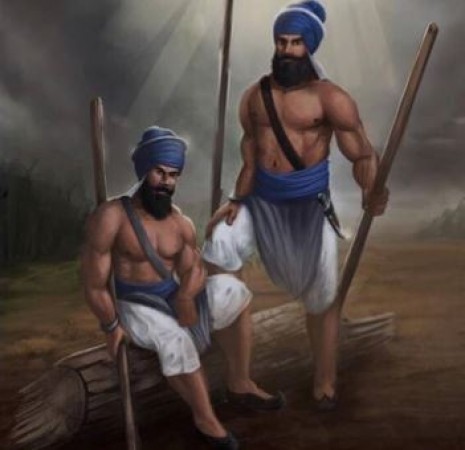
During the Battle of Chamkaur, the 10th Sikh Guru, Gobind Singh would send pairs of soldiers out to fight against the besieging Mughal forces. It was at this battle that the Sikh concept of the two tigers was born. Following the execution of Banda Singh Bahadur in 1716, Khalsa Sikhs survived by living in the jungles and mountains of Panjab. Contemporary Mughal chroniclers note that Khalsa Singhs were scarcely heard from for a generation leading many to consider living Khalsa's as a myth.
It was into this environment of harsh persecution that Bota Singh and Garja Singh not only revived the concept of the two tigers but also revived the Sikhs as a political and military force. Bota Singh Sandhu and Garja Singh Mazhabi were walking along a highway to Lahore when they spotted a Mughal patrol approaching and hid themselves off the main road into the jungle nearby. Waiting for the patrol to pass they heard a bystander tell the patrol about two Singhs he had just spotted on the road. The Mughals dismissed the notion out of hand, calling the Singhs a myth whilst another mentioned that those that used to rule the area and called themselves lions were now jackals hiding from the government. The Singhs had realised that in order to revive Khalsa prestige and Sikh power they would have to make a stand and give their lives.
Also Read: Sardaar Baaj Singh Bandai: Fearlessness in Battle
The next day, both Singhs posted themselves on a bridge near Noordin's Inn on the Tarn Taarn Road to Lahore. They started collecting taxes from any traveller that wished to cross the bridge, anyone that refused would be beaten on the spot. At that instance, on one small bridge, the two Singhs had reawakened independent Sikh sovereignty. As news of the Singhs began to spread, Bota Singh decided to write an open letter to the local Mughal Governor to create a large scene and ensure publicity. In the letter he goaded the governor by teasing the governor's wife and proclaiming the bridge to be under Khalsa taxation. The letter had its desired effect.
Within a day a force led by Jalal Din approached the Singhs on the bridge. Refusing to surrender, the Singhs asked for four of his best soldiers to fight. On defeating the Mughals in combat, the commander decided to throw his force at the two Singhs, killing them on the bridge in 1739.
Also Read: Akali Gurbaksh Singh Nihang: Shadow of Deep Singh Ji
The aims of the two Singhs however had been realised. The myth of the Khalsa was now a reality and after two decades of hiding in the jungles, the death of Bota and Garja Singh revived and reawaked Sikh aspirations. Within 2 years Sikh were once again waging wars with the Mughals and within 26 years they had conquered the capital of Panjab, Lahore. In fact, it would be a little over 60 years before Sikhs were masters of the whole of Panjab.
The two tiger concept revived on that day in 1739 has been used often times since. A year later Sukha Singh and Mehtab Singh struck Massa Rangar in Amritsar. At that point, anytime Mughals would see two Singhs together they would attack, regardless of intentions, such was the psychological fear of the concept. The concept has continued to this day with the killing of Indira Gandhi by Beant Singh and Satwant Singh, or the assasination of General Vaidya, Chief of the Army staff that invaded the Golden Temple in 1984 by Harjinder Singh and Sukhdev Singh in August 1986.
Also Read: Bhai Daya Singh Ji: First Panj Piare
Jassa Singh Ramgarhia: Age of Misls
Baba Bir Singh: Religious Preacher